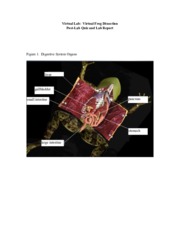

- #VIRTUAL LAB VIRTUAL FROG DISSECTION ANSWERS FOR FREE#
- #VIRTUAL LAB VIRTUAL FROG DISSECTION ANSWERS SOFTWARE#
"Likewise, with our V-Frog, you can explore nerves and blood vessels, and look closely at how the brain is wired. "You can go through the entire alimentary canal, using the endoscopic function - something you could never do with a real frog," says Chugh. Using a simple mouse and PC, students can "pick up" a scalpel, cut open V-Frog's skin, and explore the internal organs - with true real-time interaction and 3-D navigation that actually accommodates discovery and procedures not possible with a physical frog specimen.
#VIRTUAL LAB VIRTUAL FROG DISSECTION ANSWERS SOFTWARE#
The software is designed for grades 7 through 12, plus advanced placement biology students. As a result, every dissection is different, reflecting each student's individual work. V-Frog, which operates on a personal computer using a standard mouse, actually simulates nearly unlimited manipulation of specimen tissue. '01, president and chief scientist at Tactus Technologies, based in Getzville, a northern suburb of Buffalo. "Other products out there are multi-media, not true virtual reality," explains Kevin P. V-Frog, the world's first virtual-reality-based frog dissection software designed for biology education - allowing not mere observation, but physically simulated dissection - has been developed and is being marketed by Tactus Technologies.Ī provider of virtual reality, visualization and simulation products and services, Tactus Technologies is a spin-off of the University at Buffalo Virtual Reality Laboratory. Please note: This offer is only available to educators in the United States and Canada.BUFFALO, N.Y. Then we’ll be in touch with more details! To be considered for our pilot program, please fill out the form at the bottom of this page. €”California high school teacher who received virtual dissection donation

“I wanted to check in and let you know that the dissection software and computers have been fantastic! We have been working through the invertebrates and the kids are learning so much more from the virtual software—and we are saving animals! It’s been great.” €”Georgia middle school teacher who received virtual dissection donation With this application the students are able to perform repetition of the dissection … You have my students’ and my deepest appreciation, and I want you to know that the impact of your donation extends far into the lives of my students.” The students absolutely love the alternative way of learning.

We are very grateful to for your generous contribution. “The app allows students to completely understand the internal biology of the frog, and use the same dissection tools as they would in a lab to simulate the dissection process.
#VIRTUAL LAB VIRTUAL FROG DISSECTION ANSWERS FOR FREE#
Schools that choose to participate will receive humane dissection tools for free or at reduced cost and will be provided with standardized evaluation surveys for students and teachers to complete. The pilot program is designed to quantify educational efficacy and the views of students and teachers on using humane, non-animal teaching methods (e.g., digital dissection, virtual reality tools, and anatomical models). By participating in TeachKind’s dissection pilot program, you can help tackle these issues and be part of a groundbreaking effort to modernize science education. These issues include cruelty to animals by dissection-supply companies, the health hazards of exposing students to animal cadavers soaked in carcinogenic preservatives, the squandering of limited funds on repeat animal purchases, and the likelihood of deterring students (especially girls) from pursuing science careers in light of their ethical objections to dissecting animals. If your classroom, school, or district commits to replacing animal dissection with humane methods, TeachKind would love to partner with you on this exciting pilot program!Įducators and administrators who are concerned about associated issues are challenging the controversial practice of dissecting millions of animals each year in anatomy and biology classrooms. Our pilot program is designed to incorporate modern teaching tools that are aligned with the Next Generation Science Standards and offered free to qualifying schools—and to gauge teacher and student satisfaction. TeachKind has launched a new, state-of-the-art science education pilot program to teach students dissection using more effective, ethical, and economical non-animal training methods, such as interactive computer software programs and hands-on, realistic simulation models like SynFrog.


 0 kommentar(er)
0 kommentar(er)
